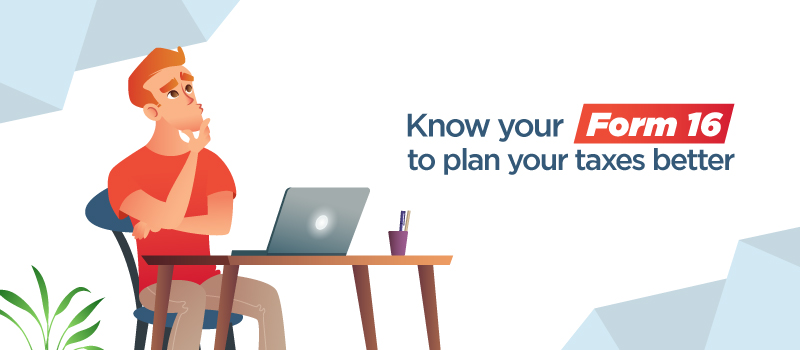
Form 16 is a certificate of proof that your tax has been deducted at source and deposited by your employer. Without it, you will have to collect and deposit all the documents related to your income, expenses and deductions like your pay slip, Form 26AS, conveyance bills, home loan proof, education loan certificate, all bank statements etc. separately.
Did you know that Form 16 is one of the most important documents required for tax filing as well as planning? It is your ‘Salary Certificate’ issued by your employer in accordance with the provisions under section 203 of the Income Tax Act. Ergo, it contains a complete and detailed record of your income earned with a clear salary break-up for the taxable financial year and all the taxes deducted at source. So, you can use this form as a single proof that, all the correct taxes have already been deducted from your salary and deposited to the government, and then you can start further planning of your investment and tax-saving strategy accordingly to claim all the benefits and residual deductions you are eligible for.
How to know if you are eligible for Form 16?
Every salaried employee is eligible to get Form 16 from his or her employer. However, it is required only if TDS is deducted from your employer’s end. So, do check with your employer for the same.
How can you get Form 16?
As a common thumb rule, most employers issue Form 16 by mid-June every year. For example, you should have received a hard copy or soft copy of Form 16 by 15th June 2018 for the financial year 2017-18.
Can you download your Form 16 online?
You can download your Form 16 online, only if your employer sends you a soft copy via email. It is a general misconception that you can download Form 16 via some trace or proxy websites using your PAN number. However, the fact is that only your employer who holds a TAN number and deducts tax on your salary can issue you the Form 16.
How to understand Form 16 for better tax planning?
Understanding Form 16 becomes fairly simple as soon as you understand its components. Now, Form 16 is divided into two parts: Part A and Part B.
Note: Form 16 Part A and Part B are different from Form 16A and Form 16B.
Form 16 Part A:
Part A of Form 16 is your TDS certificate. It is also called the ‘TRACES’ form.
Form 16 Part B:
Part B of Form 16 is an annexure and detailed record of your salary, alternate income sources, tax deducted, tax due and eligible exemptions. It contains the details as given below:
Click to view Form 16 Part A and Part B.
Here is a brief on some major terms for your better understanding:
- TAN: 10-digit alphanumeric ‘Tax Deduction and Collection Account Number’ of your employer.
- Gross Salary: Your total annual remuneration, including bonus, overtime and allowances.
- Allowances: These are the remuneration for the expenses that are incurred on behalf of the employer. For example, HRA (House Rent Allowance), Travel allowance, Medical Allowance etc. You should note that allowance exemption is done for whichever amount is the lowest. For example, suppose your income is INR 30k and your HRA as mentioned in the salary break-up is 15k. Now if you live in a metro city the whole amount, i.e. 15k, will be tax exempt as 50% of your salary is allowed HRA exemption, but if you live in a non-metro city, you will get tax exemption for only 12k (even if the salary break-up for HRA is 15k) as only 40% of salary is allowed HRA exemption for non-metros.
- Pre-requisites: These are your additional benefits, like rent-free accommodation for employees.
- Profits in lieu of Salary: These include payments related to the termination or modification of terms of employment, such as Pension, Gratuity, and Retrenchment Compensation etc. These payments are a part of your salary and hence are taxable.
- Deductions: These are the tax breaks allowed on a certain kind of savings and investments.
- Relief u/s 89: You are eligible for tax relief when you get your salary in arrears in a lump sum. For example, late payment of salary, or retrenchment compensation, or pension and other retirement benefits like Gratuity.
- Education Cess: It is the contribution made for the higher education development in the country. Every individual is required to pay 3% education cess out of the total tax payable.
All in all, Form 16 can make your tax computation easier as it contains all the information and proof in one place. So, don’t forget to get Form 16 if your employer deducts TDS. The same goes for pension holders, check with your bank in case any TDS is deducted and get your Form 16 before filing your taxes. In case you need any clarification or have any queries, contact us at support@5nance.com




